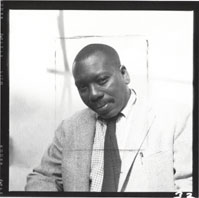




 |
 |
 |
 |
 |
||
|
 In the summer of 1946 Lawrence was invited by artist and director |
|||||||||||||||
| In 1949
Lawrence voluntarily sought help for depression at Hillside Hospital in
Queens, New York. His hospital paintings during this time show a marked
departure from his other works. The people in these paintings are resigned,
their facial features agonized; the colors are mixed and subdued. His eleven
month's at Hillside gave Lawrence a fresh perspective on Harlem and the
subjects of his earlier works. He began visiting theatrical productions,
and in 1951 created a new body of work based on his memories of performances
at the During the 1950s, Lawrence’s art developed greater psychological depth due to the influence of many elements. This depth is expressed through greater layering of patterns and increased use of shadow and light. With the publication of |
 Jacob Lawrence, 1950s. Photograph by William Grigsby Artwork © Gwendolyn Knight Lawrence, courtesy of the Jacob and Gwendolyn Lawrence Foundation |
|||||||||||||||
©2002 Whitney Museum of American Art |